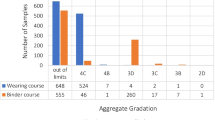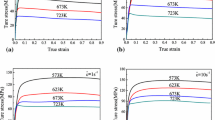Abstract
In this paper, an attempt has been made to evaluate and predict the air flow rate in triaxial conditions at various confining pressures incorporating cell pressure, air inlet pressure, and air outlet pressure using artificial neural network (ANN) technique. A three-layer feed forward back propagation neural network having 3-7-1 architecture network was trained using 37 data sets measured from laboratory investigation. Ten new data sets were used for the, validation and comparison of the air flow rate by ANN and multi-variate regression analysis (MVRA) to develop more confidence on the proposed method. Results were compared based on coefficient of determination (CoD) and mean absolute error (MAE) between measured and predicted values of air flow rate. It was found that CoD between measured and predicted air flow rate was 0.995 and 0.758 by ANN and MVRA, respectively, whereas MAE was 0.0413 and 0.1876.








Similar content being viewed by others
References
Darcy H (1856) Les Fontaines Publiques de la Ville de Dijon. Victor Dalmond, Paris
Forchheimer P (1901) Wasserbewegung durch Boden. Z Ver Deutsch Ing 45:1782–1788
Bear J (1972) Dynamics of fluids in porous media. Elsevier, New York
Hannoura A, Barends FBJ (1981) Non-Darcy flow: a state of art. In: Verruijt A, Barends FBJ (eds) Proceedings of the euromech 143. Balkema PC, Rotterdam, pp 37–51
Scheidegger AE (1974) The physics of flow through porous media, 3rd edn. University of Toronto Press, Toronto
Pyrak-Nolte LJ, Myer LR, Cook NGW, Witherspoon PA (1987) Hydraulic and mechanical properties of natural fractures in low permeability rock. In: 6th International congress rock mechanics, ISRM, Montreal, Canada, pp 225–231
Raven KG, Gale JE (1985) Water flow in a natural rock fracture as a function of stress and sample size. Int J Rock Mech Min Sci Geomech Abstr 16:225–234
Durham WB, Bonner BP (1994) Self-propping and fluid flow in slightly offset joints at high effective pressures. J Geophys Res 99:9391–9399
Jaeger JC, Cook NGW (1976) Fundamentals of rock mechanics. Chapman and Hall, London, pp 169–171
Brown SR (1987) Fluid flow through rock joints: the effect of surface roughness. J Geophys Res 92:1337–1347
Pratt HR, Swolfs HS, Brace WF, Black AD, Handin JW (1977) Elastic and transport properties of an in situ jointed granite. Int J Rock Mech Min Sci Geomech Abstr 14:34–45
Tsang YW (1984) The effect of tortuosity on fluid flow through a single fracture. Water Resour Res 20:1205–1215
Zimmerman RW, Chen DW, Cook NGW (1992) The effect of contact area on the permeability of fractures. J Hydrol 139:79–96
Durham WB (1997) Laboratory observations of the hydraulic behavior of a permeable fracture from 3800 m depth in the KTB pilot hole. J Geophys Res 102:18405–18416
Oron AP, Berkowitz B (1998) Flow in rock fractures: the local cubic law assumption reexamined. Water Resour Res 34:2811–2825
Skjetne E, Hansen A, Gudmundsson JS (1999) High-velocity flow in a rough fracture. J Fluid Mech 383:1–28
Zimmerman RW, Yeo IW (2000) Fluid flow in rock fractures: from the Navier–Stokes equations to the cubic law. In: Dynamics of fluids in fractured rock, geophysical monograph 122, American geophysical union, pp 213–224
Iwai K (1976) Fundamental studies of fluid flow through a single fracture. PhD dissertation, University of California, Berkeley, California
Al-Yaarubi A (2003) Numerical and experimental study of fluid flow in a rough-walled rock fracture. PhD dissertation, Imperial College, London
Zimmerman RW, Al-Yaarubi A, Pain CC, Grattoni CA (2004) Non-linear regimes of fluid flow in rock fractures. Int J Rock Mech Min Sci 41(supplement A):163–169
Wittke W (1990) Rock mechanics: theory and applications with case histories. Springer, Berlin
Lee CH, Farmer I (1993) Fluid flow in discontinuous rocks. Chapman and Hall, London
Khandelwal M, Roy MP, Singh PK (2004) Application of artificial neural network in mining industry. Ind Min Eng J 43:19–23
Rajasekaran S, Pai GAV (2005) Neural networks, fuzzy logic and genetic algorithms: synthesis and applications. Prentice Hall, New Delhi
Khandelwal M (2002) Application of neural network for the prediction of triaxial constants from uniaxial compressive strength. MTech dissertation, Department of Mining Engineering, Banaras Hindu University, Varanasi, India
Maulenkamp F, Grima MA (1999) Application of neural networks for the prediction of the unconfined compressive strength (UCS) from Equotip hardness. Int J Rock Mech Min Sci 36:29–39
Yang Y, Zhang Q (1997) Analysis for the results of point load testing with artificial neural network. In: Proceedings of the computer methods and advances in geomechanics, IACMAG, China, pp 607–612
Cai JG, Zhao J (1997) Use of neural networks in rock tunneling. Proceedings of the computer methods and advances in geomechanics, IACMAG, China, pp 613–618
Khandelwal M, Singh TN (2002) Prediction of waste dump stability by an intelligent approach. National symposium new equipment—new technology, management and safety, ENTMS, Bhubaneshwar, pp 38–45
Maity D, Saha A (2004) Damage assessment in structure from changes in static parameters using neural networks. Sadhana 29:315–327
Khandelwal M, Singh TN (2009) Prediction of blast induced ground vibration using artificial neural network. Int J Rock Mech Min Sci 46(7):1214–1222
Khandelwal M, Singh TN (2010) Prediction of macerals contents of Indian coals from proximate and ultimate analyses using artificial neural network. Fuel 89(5):1101–1109
Khandelwal M, Singh TN (2010) Artificial neural network as a valuable tool for well log interpretation. Petroleum Sci Technol 28(14):1381–1393
Bhatnagar A, Khandelwal M (2010) An intelligent approach to evaluate drilling performance. Neural Comput Appl. doi:10.1007/s00521-010-0457-6 (online published)
Monjezi M, Bahrami A, Yazdian Varjani A (2010) Simultaneous prediction of fragmentation and flyrock in blasting operation using artificial neural networks. Int J Rock Mech Min Sci 47(3):476–480
Monjezi M, Ahmadi M, Sheikhan M, Bahrami A, Salimi AR (2010) Predicting blast-induced ground vibration using various types of neural networks. Soil Dyn Earthq Eng 30(11):1233–1236
Simpson PK (1990) Artificial neural system—foundation, paradigm, application and implementations. Pergamon Press, New York
Khandelwal M, Singh TN (2006) Prediction of blast induced ground vibrations and frequency in opencast mine—a neural network approach. J Sound Vibration 289:711–725
Monjezi M, Dehghani H (2008) Evaluation of effect of blasting pattern parameters on back break using neural networks. Int J Rock Mech Min Sci 45(8):1446–1453
Lanaro F (2000) A random field model for surface roughness and aperture of rock fractures. Int J Rock Mech Min Sci 37:1195–1210
Zimmerman RW, Bodvarsson GS (1996) Hydraulic conductivity of rock fractures. Transp Porous Media 23:1–30
Baheer I (2000) Selection of methodology for modeling hysteresis behavior of soils using neural networks. J Comput Aided Civ Infrastruct Eng 5(6):445–463
Hecht-Nielsen R (1987) Kolmogorov’s mapping neural network existence theorem. In: Proceedings of the first IEEE international conference on neural networks, San Diego, CA, pp 11–14
Masters T (1994) Practical neural network recipes in C++. Academic Press, Boston
Lippmann RP (1987) An introduction to computing with neural nets. IEEE ASSP Mag 4:4–22
Rumelhart DE, Hinton GE, Williams RJ (1986) Learning internal representation by error propogation. In: Rumelhart DE, McClelland JL (eds) Parallel distributed processing, vol 1, pp 318–362
MacKay DJC (1992) Bayesian interpolation. Neural Comput 4:415–447
Hush DR (1989) Classification with neural networks: a performance analysis. Proceedings of the IEEE international conference on systems Engineering Dayton Ohia, USA, 277–80
Ripley BD (1993) Statistical aspects of neural networks. In: Barndoff-Neilsen OE, Jensen JL, Kendall WS (eds) Networks and chaos-statistical and probabilistic aspects. Chapman & Hall, London, pp 40–123
Wang C (1994) A theory of generalization in learning machines with neural application. PhD thesis, The University of Pennsylvania, USA
Kanellopoulas I, Wilkinson GG (1997) Strategies and best practice for neural network image classification. Int J Remote Sensing 18:711–725
Author information
Authors and Affiliations
Corresponding author
Rights and permissions
About this article
Cite this article
Ranjith, P.G., Khandelwal, M. Artificial neural network for prediction of air flow in a single rock joint. Neural Comput & Applic 21, 1413–1422 (2012). https://doi.org/10.1007/s00521-011-0595-5
Received:
Accepted:
Published:
Issue Date:
DOI: https://doi.org/10.1007/s00521-011-0595-5




